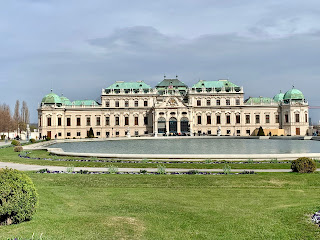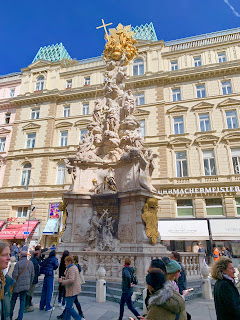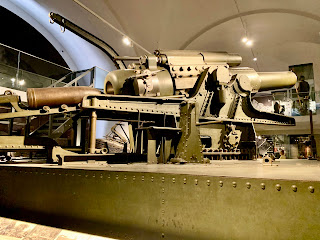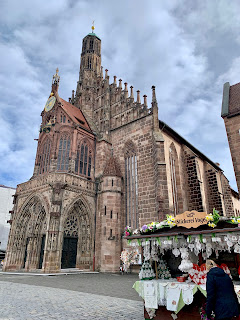26th - 28th Mar 202
 |
| Looking south from the Donauturm over the Danube and 'low-rise' Vienna. THIS EDITION IS GETTING LONG AS I KEEP ADDING TO IT! KEEP SCROLLING DOWN IF YOU ARE STILL INTERESTED. NOW FINISHED! I believe this city is nicknamed 'City of Dreams' thanks to the influence of the late local 'shrink' Sigmund Freud. ....Or possibly due to the proliferation of these dope shops (left), of which I saw at least three. They seem to be popular and plentiful here as I also noticed last year in Portugal and Poland. They haven't yet caught on in UK possibly because the inhabitants are deemed 'dopey' enough already. Our rabble (right) assembled at the Nuremburg Hbf at 10.00am to catch the 11.01 ICE train to Vienna. It was delayed until 11.30. So it's not just British trains that get delayed. Our tickets were checked regularly by rather officious inspectors. Arrived Vienna at 3.15pm and bus to the Hotel Ananas which was comfortable but pathetic WiFi in rooms, or at least in mine. Then on a group march to see the local sights and to get our bearings. The hotel was at the southern end of town. We were taken around to the local Metro station and it seems that most of the Metro system in Vienna is undergoing renovations with many roadworks in evidence as a result, especially around our hotel. The walk towards the centre took us through the expansive 'nachtmarkt' (left) which has four long lines of stalls selling fruit, veg, cakes and sweets plus numerous bars and restaurants. As it turned out the restaurants were rather good (if a bit expensive). The large Metro station, Karlsplatz (right) was at the northern end of the market. There are several entry points and tram/bus stops over a large area and some had this rather attractive 'art deco' frontage. Pity about the scruffy graffiti. Talking of which, who does all this graffiti, and why?...so common around all stations and on hoardings in all countries. I have never seen, met or even heard of a graffitist (apart from the talented Banksy). Who are they, what is the point of it (the unartistic ones) and what pleasure does it give to those responsible? Answers please! The underground Metro system around the city is excellent and easy to use, but the tram and bus system is very confusing and difficult to locate the correct stops.  Just north of this (left) is the gothic style St Charles Church (Karlskirche) which was completed in 1737 (it took over 20 years to build) and was to commemorate the end of the last plague at the beginning of that century. No graffiti there! Just north of this (left) is the gothic style St Charles Church (Karlskirche) which was completed in 1737 (it took over 20 years to build) and was to commemorate the end of the last plague at the beginning of that century. No graffiti there!We walked back to the hotel for another 'communal' supper at a nearby restaurant. I was seated between a bloke whose only interest and topic of conversation was football, and a lady who never spoke a word. I noticed on the train that she and her husband read The Guardian. Opposite me was a very eccentric man who had been a 'therapist' and judo instructor (long retired) and was now 'into' Germanic culture. He was teetotal and a vegan. As you can imagine we didn't have a lot in common. The food was OK. The next day featured a bus tour followed by a walking tour of the city conducted by an enthusiastic Austrian lady guide. She said she and her family had only lived in Vienna for 30 years so she cannot be considered properly 'Viennese'. We were all issued with 'Vox' boxes with earpieces to listen to her commentary while on foot. She spared no effort in talking....rarely taking the chance to take a breath it seemed! Verbal diarrhea! The trouble with these non-stop talks giving constant minute detail is that, especially on the bus, it is difficult to assimilate it all and see what she is describing, especially her encyclopedic descriptions of the very complicated Austrian/European history since the middle ages. Our group looked suitably baffled. Shortly after leaving the hotel she said we should look out for the 'cabbages'. I looked out to no avail. Her accent, not being perfect, she meant 'carriages' ie. posh horses and carts towing, at vast cost, weathy tourists around the streets. There were indeed many of these. Left: Our first port of call was the impressive 'baroque' Belvedere Palace, built 1723, located to the south-east of the old town. It is, as with so much architecture in this town, a most impressive building. Right: The palace gardens to the city (north) side were supposedly intended as a smaller version of those at Versailles, Paris. They looked a rather scruffy version to my untrained eye. The grass needed cutting....as does mine at home. The Palace itself includes stables (probably with 'cabbages') and houses a museum displaying, amongst much else, many works by the famous Viennese artist Gustav Klimpt, including his best known daubing 'The Kiss' (Der Kuss). We did not go in. Why bother? I can easily see his pictures merely by looking them up. I will also save my reader the bother. So here is his 'The Kiss' (left). His other paintings all look rather similar in style and colouring. Right: The Viennese Parliament building located on the Ringstrasse Boulevarde to the west of the city centre. Another fine piece of architecture. We just drove past it. Left: A line of 'cabbages' outside the entrance to the Hofburg Palace. Right: The grand entrance to the Hofburg Palace and other regal buildings from the Habsburg, Austro-Hungarian and regal periods of the likes of Emperor Franz-Josef etc. The history of this part of the world is very complicated and our 'guide' tried to explain some of it....but too much for me to take in! Left: (not my photo). Inside here is the home of the Spansh Riding School and their stables. Another Habsburg invention which features grey Lipizzaner horses ridden by elaborately dressed riders poncing about an arena to display their OTT dressage skills. They go on tours worldwide. I visited to watch a display many years ago so didn't join the queue to see it again. They now have women riders. What is the world coming to!? Right: At the far end are the quarters of the late Empress Elizabeth (nickname Lisi) who was married at the age of 16 to Emperor Franz Joseph. She was assassinated, by a nutter, in Geneva, Switzerland, in 1898 aged 60. She was a very popular Empress, apparently. On the right of the photo is the entrance to the main Palace. Left: Just outside (to the left of the photo above) is the Neueburg wing of the Palace (was the Town Hall) with what is now considered an 'infamous' balcony. From this balcony in March 1938 a Mr A. Hitler gave his rousing speech to cheering Austrians when he announced that his 'birth country' had been incorporated into the Third Reich; an event known as the Anschluss. Nobody is now allowed to use the balcony. I believe the building is presently a museum. Right: The grand State Opera House at the southern end of Kärnter Strasse in the city centre. Austria is renowned for its classical music and was home to various famous composers such as Mozart, Liszt, Haydn, Schubert, Strauss and Benny Goodman, amongst others. I can't remember what is showing at the moment. Not, I suspect, Mary Poppins. It is normally difficult and expensive to get tickets. Left: I can't remember what this building is. I just show it as another example of the varied elegant architecture which features throughout this city. I passed it en-route to the very large, smart and efficient city centre main Post Office. Why do foreign countries (ie. not UK) take such pride in their main Post Offices (see Saigon and Taipei as typical examples). The UK just has scruffy and inefficient little establishments with long queues. * I have just been informed by that admirable and alert 'research' organisation 'OMPITA' that the building above is the 'Greek Church of the Holy Trinity'. Well I never. Right: Flanagan's 'Oirish' bar. A decent pit-stop and featured two amusing and genuinely Irish barmen! We discussed the forthcoming Irish Grand National over a pint of Guinness. They told me there are quite a few Irish working in Vienna. Left: No idea what this statue is, somewhere in the centre. I took the photo because it looked appealing and forgot to note what it represented. However, the research team at the invaluable OMPITA organisation (they tirelessly monitor my blog) came up with the following: The Plague Column (German: die Wiener Pestsäule), or Trinity Column (German: Dreifaltigkeitssäule), is a Holy Trinity column located on the Graben, a street in the inner city of Vienna, Austria. Erected after the Great Plague epidemic in 1679. Right: St.Stephen's Cathedral in Stephansplatz. It was built mid-14th century and is the central point of Vienna. It is possible to climb, 256 steps, up the large spire. Good views I'm sure, but I didn't bother; went up the Donauturm instead. |





















































